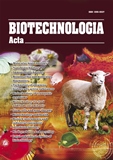ISSN 2410-7751 (Print)
ISSN 2410-776X (Online)

Biotechnologia Acta Т. 18, No. 3, 2025
P. 14-22, Bibliography 19 , Engl.
UDC 579.22:577.322
doi: https://doi.org/10.15407/biotech18.03.014
APPLICATION OF REVERSE MOLECULAR DOCKING FOR THE IDENTIFICATION OF PROTEIN TARGETS OF S-ETHYLTHIOSULFANYLATE INVOLVED IN BIOSURFACTANT BIOSYNTHESIS
Yanvarov Y.B., Havryliak V.V.
Lviv Polytechnic National University, Ukraine
Aim. The study is focused on determining the effect of the ligand S-ethylthiosulfanylate on protein targets involved in the synthesis of biosurfactants and evaluating their potential interaction.
Materials and Methods. A reverse docking approach was employed to investigate the interaction of a single ligand with 8 protein targets. Molecular docking was performed using AutoDock Vina with the Vina scoring function. The preparation of the ligand and protein targets was carried out using AutoDockTools from the MGLTools package. Visualization of the results was accomplished using ChimeraX and BIOVA Discovery Studio.
Results. Docking the ligand with 8 protein targets enabled the identification of three promising targets — 3RKY, 2B4Q, and 8IK2 — with affinities lower than –5,5 kcal/mol. Predominantly, hydrogen bonds and hydrophobic interactions were observed, indicating the stability of ligand binding within the active sites of these proteins.
Conclusion. The study confirmed the effectiveness of reverse docking for identifying potential protein targets, demonstrating that the ligand can influence biosurfactant biosynthesis through specific interactions with proteins 3RKY, 2B4Q, and 8IK2.
Keywords: biosurfactants, S-ethylthiosulfanylate, reverse molecular docking, ligand-protein interaction, affinity, target prediction.
© Palladin Institute of Biochemistry of the National Academy of Sciences of Ukraine, 2025
References
- Jumper, J., Evans, R., Pritzel, A., Green, T., Figurnov, M., Ronneberger, O., Tunyasuvunakool, K., Bates, R., Zidek, A., Potapenko, A., Bridgland, A., Meyer, C., Kohl, S. A. A., Ballard, A. J., Cowie, A., Romera-Paredes, B., Nikolov, S., Jain, R., Adler, J., … Hassabis, D. (2021). Highly accurate protein structure prediction with AlphaFold. Nature, 596(7873), 583-589. https://doi.org/10.1038/s41586-021-03819-2
- Jumper, J., & Hassabis, D. (2022). Protein structure predictions to atomic accuracy with AlphaFold. Nature Methods, 19(1), 11-12. https://doi.org/10.1038/s41592-021-01362-6
- Abramson, J., Adler, J., Dunger, J., Evans, R., Green, T., Pritzel, A., Ronneberger, O., Willmore, L., Ballard, A. J., Bambrick, J., Bodenstein, S. W., Evans, D. A., Hung, C.-C., O’Neill, M., Reiman, D., Tunyasuvunakool, K., Wu, Z., Zemgulyte, A., Arvaniti, E., … Jumper, J. M. (2024). Accurate structure prediction of biomolecular interactions with AlphaFold 3. Nature, 630(8016), 493-500. https://doi.org/10.1038/s41586-024-07487-w
- Krause, F., Voigt, K., Di Ventura, B., & Ozturk, M. A. (2023). ReverseDock: A web server for blind docking of a single ligand to multiple protein targets using AutoDock Vina. Frontiers in Molecular Biosciences, 10. https://doi.org/10.3389/fmolb.2023.1243970
- Wang, H., He, H., Zhang, T., & Jiang, J. (2022). Application of Reverse Docking in the Research of Small Molecule Drugs and Traditional Chinese Medicine. Biological and Pharmaceutical Bulletin, 45(1), 19-26. https://doi.org/10.1248/bpb.b21-00324
- Luo, Q., Wang, S., Li, H. Y., Zheng, L., Mu, Y., & Guo, J. (2024). Benchmarking reverse docking through AlphaFold2 human proteome. Protein Science, 33(10), e5167. https://doi.org/10.1002/pro.5167
- Kharkar, P. S., Warrier, S., & Gaud, R. S. (2014). Reverse Docking: A Powerful Tool for Drug Repositioning and Drug Rescue. Future Medicinal Chemistry, 6(3), 333-342. https://doi.org/10.4155/fmc.13.207
- Lubenets, V. I., Baranovych, D. B., Yarish, M. Ye., Voloshynets, V. A., & Novikov, V. P. (2001). Synthesis of S-[2-(arylsulfonyl)ethyl]thiosulfonates and their hydrolysis. khym. zhurn, 67(11-12), 103-109. (In Ukrainian)
- Deziel, E., Lepine, F., Milot, S., & Villemur, R. (2003). rhlA is required for the production of a novel biosurfactant promoting swarming motility in Pseudomonas aeruginosa: 3-(3-hydroxyalkanoyloxy)alkanoic acids (HAAs), the precursors of rhamnolipids. Microbiology, 149(8), 2005-2013. https://doi.org/10.1099/mic.0.26154-0
- Campos-Garcia, J., Caro, A. D., Najera, R., Miller-Maier, R. M., Al-Tahhan, R. A., & Soberon-Chavez, G. (1998). The Pseudomonas aeruginosa rhlG gene encodes an NADPH-dependent beta-ketoacyl reductase which is specifically involved in rhamnolipid synthesis. Journal of Bacteriology, 180(17), 4442-4451. https://doi.org/10.1128/jb.180.17.4442-4451.1998
- Quiocho, F. A., & Vyas, N. K. (1984). Novel stereospecificity of the L-arabinose-binding protein. Nature, 310(5976), 381-386. https://doi.org/10.1038/310381a0
- Bruner, S. D., Weber, T., Kohli, R. M., Schwarzer, D., Marahiel, M. A., Walsh, C. T., & Stubbs, M. T. (2002). Structural Basis for the Cyclization of the Lipopeptide Antibiotic Surfactin by the Thioesterase Domain SrfTE. Structure, 10(3), 301-310. https://doi.org/10.1016/s0969-2126(02)00716-5
- Miller, D. J., Zhang, Y.-M., Rock, C. O., & White, S. W. (2006). Structure of RhlG, an Essential β-Ketoacyl Reductase in the Rhamnolipid Biosynthetic Pathway of Pseudomonas aeruginosa. Journal of Biological Chemistry, 281(26), 18025-18032. https://doi.org/10.1074/jbc.m601687200
- Samel, S. A., Wagner, B., Marahiel, M. A., & Essen, L.-O. (2006). The Thioesterase Domain of the Fengycin Biosynthesis Cluster: A Structural Base for the Macrocyclization of a Non-ribosomal Lipopeptide. Journal of Molecular Biology, 359(4), 876-889. https://doi.org/10.1016/j.jmb.2006.03.062
- Pendini, N. R., Yap, M. Y., Polyak, S. W., Cowieson, N. P., Abell, A., Booker, G. W., Wallace, J. C., Wilce, J. A., & Wilce, M. C. J. (2013). Structural characterization of Staphylococcus aureus biotin protein ligase and interaction partners: An antibiotic target. Protein Science, 22(6), 762-773. http://doi.org/10.1002/pro.2262
- Tufar, P., Rahighi, S., Kraas, F. I., Kirchner, D. K., Lohr, F., Henrich, E., Kopke, J., Dikic, I., Güntert, P., Marahiel, M. A., & Dötsch, V. (2014). Crystal Structure of a PCP/Sfp Complex Reveals the Structural Basis for Carrier Protein Posttranslational Modification. Chemistry & Biology, 21(4), 552-562. https://doi.org/10.1016/j.chembiol.2014.02.014
- Folger, I. B., Frota, N. F., Pistofidis, A., Niquille, D. L., Hansen, D. A., Schmeing, T. M., & Hilvert, D. (2024). High-throughput reprogramming of an NRPS condensation domain. Nature Chemical Biology, 20(6), 761-769. https://doi.org/10.1038/s41589-023-01532-x
- Tang, T., Fu, L., Xie, W., Luo, Y., Zhang, Y., Zhang, J., & Si, T. (2023). RhlA Exhibits Dual Thioesterase and Acyltransferase Activities during Rhamnolipid Biosynthesis. ACS Catalysis, 13(8), 5759-5766. https://doi.org/10.1021/acscatal.3c00046
- Eberhardt, J., Santos-Martins, D., Tillack, A. F., & Forli, S. (2021). AutoDock Vina 1.2.0: New Docking Methods, Expanded Force Field, and Python Bindings. Journal of Chemical Information and Modeling, 61(8), 389103898. http://doi.org/10.1021/acs.jcim.1c00203

